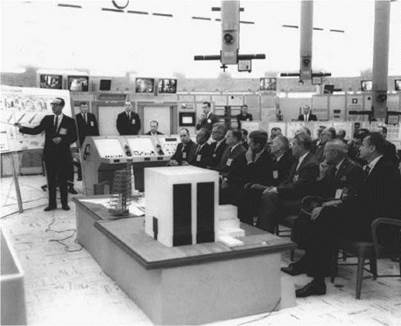A Final Kennedy Visit to the Apollo Launch Site
On November 16, 1963, John Kennedy made the short flight to Cape Canaveral from his family home in Palm Beach, Florida for an inspection tour of progress being made by NASA in the Gemini and Apollo programs. He also took a helicopter to a Navy ship offshore to witness the launch of a submarine-based Polaris missile. The president’s visit was seen as “an effort to focus attention on the nation’s space program” as the Congress made final decisions on the NASA FY1964 budget.
Kennedy was first briefed on the Gemini program by astronauts Gus Grissom and Gordon Cooper. He then had a short presentation on Apollo by George Mueller in the launch control center at Launch Complex 37; a Saturn 1 booster was sitting on that launch pad for a planned December launch attempt. As his party left the control center, the president lagged behind to inspect the models of the various launch vehicles being used by NASA, ranging from the small Redstone booster that had been used for the suborbital launches of Alan Shepard and Gus Grissom to the mighty Saturn V that would be used to send astronauts to the Moon. When he was assured that the models were all to the same scale, Kennedy used words like “amazing” and “fantastic.” Robert Seamans, who accompanied Kennedy throughout the visit, suggests that the President “maybe for the first time, began to realize the dimensions of these projects.”
|
President Kennedy is briefed on Apollo plans by associate administrator for manned space flight George Mueller on November 16, 1963. In the first row (l—r) are: manned space flight official George Low; director of NASA’s Launch Operations Center Kurt Debus; NASA associate administrator Robert Seamans; NASA administrator James Webb; the president; NASA deputy administrator Hugh Dryden; director of Marshall Spaceflight Center Wernher von Braun; commander of the Air Force Missile Test Center at Cape Canaveral Major General Leighton Davis; and Senator George Smathers (D-FL). In front of the president is a model of the massive Vehicle Assembly Building within which the Saturn V moon rocket, also shown, would be assembled before being transported to the launch pad (NASA photograph). |
Kennedy then walked to the vicinity of the Saturn 1 booster, where he was briefed on the rocket’s dimensions and capabilities by Wernher von Braun (see cover image). Before leaving the launch pad, and much to the discomfort of his Secret Service detail, Kennedy walked over and stood directly underneath the rocket. At that moment, he asked whether the upcoming launch “will be the largest payload that man has ever put in orbit.” When told that this was indeed the case, Kennedy responded: “That is very, very significant.” He recognized that with the upcoming launch the United States would finally surpass the Soviet Union in lifting capacity, a goal that he had pursued from his first presidential decisions on space. The party then flew by helicopter over the Saturn V launch facilities under construction at Launch Complex 39 on the adjoining Merritt Island; Kennedy had been shown a model of the complex during his earlier briefing by Mueller.
As he returned to the mainland after witnessing the Polaris launch, Kennedy said to Seamans, “I’m not sure that I have the facts really straight” with respect to the launch capability of the Saturn 1. “Will you tell me about it again?” Seamans responded that “the usable payload is 19,000 pounds, but we’ll actually have 38,000 pounds up there in orbit.” The rocket’s liftoff thrust would be 1.5 million pounds. Kennedy then asked, “what is the Soviet capability?” and Seamans told him that it was approximately 15,000 pounds of usable payload and that the Soviet booster had only a lift-off thrust of 800,000 pounds. Kennedy once again said: “That’s very important. Now, be sure that the press understands this.” As he was preparing to return to Palm Beach, he turned to Seamans and said: “Now, you won’t forget, will you, to do this?” He asked Seamans to get on the press plane to emphasize that the United States would soon close the weight-lifting gap in space. Seamans was successful in his presidentially assigned mission. The New York Times reported the next day that Kennedy was “enthralled by the sight of the Saturn 1 vehicle, which is expected to make space history next month” by putting the United States ahead of the Soviet Union in the weight placed in orbit.13
Six days later, on the short flight from Fort Worth to Dallas, John F. Kennedy told Representative Olin Teague that “he wanted to go to the Cape for the Saturn launch in December. He thought the space program needed a boost and he wanted to help.”14











